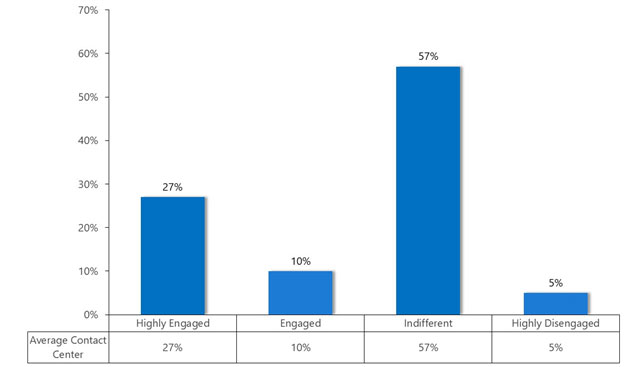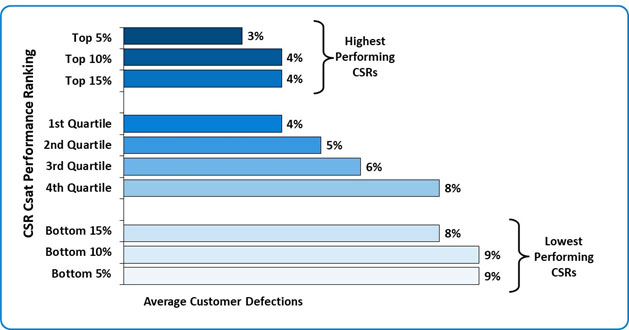
Agent Engagement Impact on CX and Profitability
Since 1996, SQM has helped clients bridge the gap that exists between customer experience (CX) strategies and human resource initiatives. For example, we measure employee satisfaction, engagement, retention, and HR practices for helping organizations deliver positive customer experiences. I thought it would be helpful to share our employee and customer research data which is based on benchmarking over 500 leading North American contact centers.
Figure 1 shows the Employee Engagement Index among Customer Service Representatives (CSRs) working in a contact center. SQM research data shows that only 27% of CSRs are highly engaged, 10% are engaged, a whopping 57% are indifferent working at a contact center, and 5% are highly disengaged and at risk of leaving the contact center. CSR engagement is based on three metrics: overall satisfaction with working in the contact center, willingness to continue working in the contact center, and willingness to recommend working in the contact center to others. Highly engaged CSRs really care about resolving customer contacts and retaining customers, whereas indifferent CSRs and highly disengaged CSRs are not as committed to resolving customer contacts and retaining customers. It is SQM’s belief that organizations should evaluate their HR practices on employee satisfaction, engagement, retention, as well as customer experience and defections.

Figure 1
Source: SQM - Employee Engagement Index
We have all heard the old adage, “happy employees make happy customers.” SQM’s research definitely confirms that this saying is true. I should also point out that “happy customers make happy employees” because the employees do not have to deal with as many dissatisfied customers.
Figure 2 shows the ranking of CSR customer satisfaction (Csat) performance impact on customer defections. The top 15% of CSRs for Csat performance have an average of 4% customer defections as a result of the service they delivered, while the bottom 15% have an average of 8% customer defections as a result of the service they delivered. Average annual revenue lost as a result of customer defections for the top 15% of CSRs was $708,000 and $1,416,000 for the bottom 15% of CSRs. It would be cheaper for contact centers to pay the worst performing CSRs to stay at home and replace them with new CSRs, rather than have the worst CSRs take calls. Put simply, high employee engagement and great HR practices lead to high Csat and customer retention. Furthermore, for most SQM clients, improving employee engagement represents the best opportunity for improving their customer service and lowering their operating costs.

Figure 2
Source: SQM – CSR Impact on Customer Defections
Jack Welch, the former CEO of GE, famously argued that leaders need to fire the bottom 10% of their workforce each year in order to continually improve their performance. For improving customer experience (CX) and costs, a question that we are often asked at SQM is whether it is more beneficial to focus on the entire workforce, the top 10%, or the bottom 10%. My standard answer is that it is dependent on your current performance. For example, we have several clients who have used the Jack Welch approach of firing the bottom 10%. Although many of our clients find this approach to be too draconian. However, I can tell you that we have awarded these organizations for significantly improving their CX performance, while at the same time reducing their operating costs.
It is important to mention that our clients who benefit from the practice of firing the bottom 10% tend to be fourth quartile CX and operational cost performers. We also have clients who have focused on providing more coaching with the bottom 10%, which has been a hit and miss approach for improving CX.
SQM clients who have used a holistic performance management system that focuses on motivation (e.g., recognition, rewards, and compensation) and performance accountability (e.g., goals, performance, coaching, and a poor performance penalty system) have been successful for improving overall CX across their entire workforce.
The Voc performance management practice focus has been more successful than just providing coaching for improving CX for the bottom 10%. The bottom line is that a performance management system can be powerful for improving CX and lowering operating costs. When SQM evaluated CSRs, who were underperforming for providing positive CX, we determined that when a customer was dissatisfied with a CSR, 62% of the time it was due to a “Will Issue”, and 38% of the time was due to a “Skill Issue.”
Most organizations tend to focus on “Skill Issues” versus “Will Issues.” However, an effective performance management system addresses both “Will and Skill” issues. In my professional opinion, CSR “Will and Skill” issues are not measured often enough, and most performance management systems do not address the differences enough.
Quick Related Links
First Call Resolution Definition First Call Resolution PPT First Call Resolution Benefits
First Call Resolution Strategies First Call Resolution Operating Philosophy Call Handling Best vs Worst Agents Agent Recognition Celebrating Agent Success QA Form Customer Quality Assurance Survey Data Coaching Tips What is a Good FCR Rate? VoC Closed-loop Top 10 CX Metrics Agent Recognition Case Study VoC Performance Management VoC Agent Performance Case Study Agent Training
